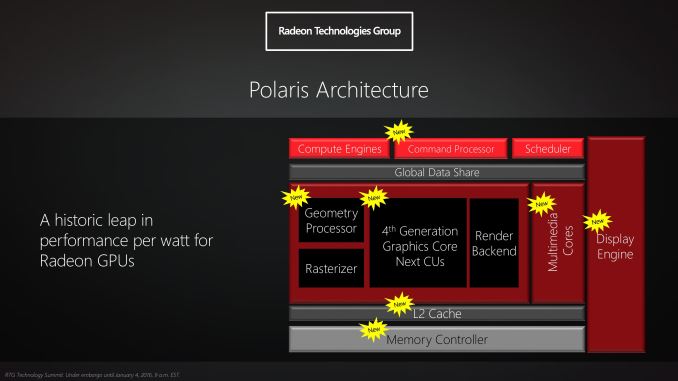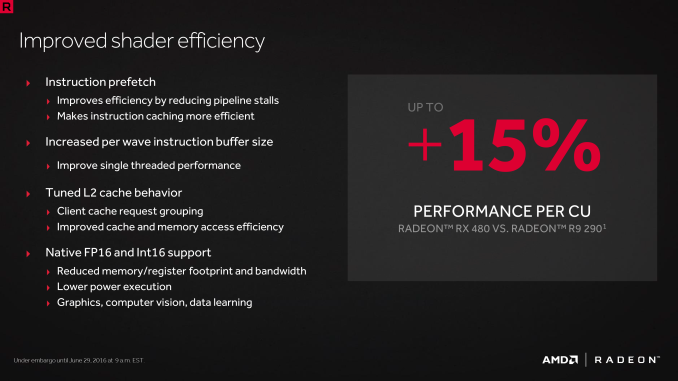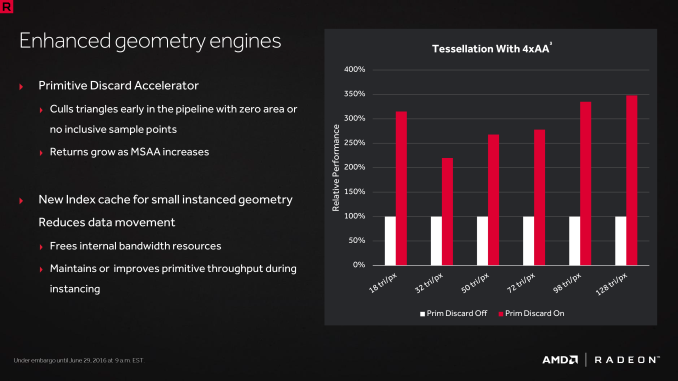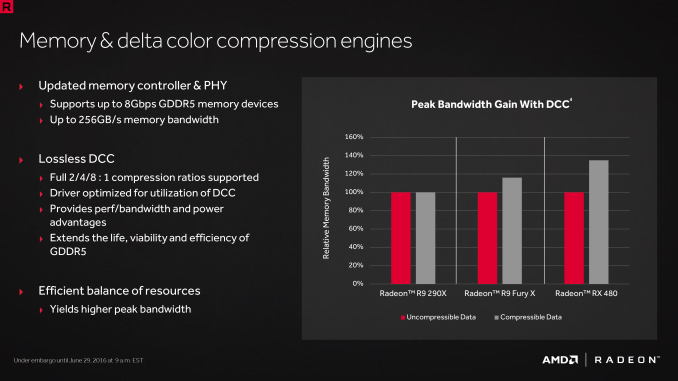The AMD Radeon RX 480 Preview: Polaris Makes Its Mainstream Mark
by Ryan Smith on June 29, 2016 9:00 AM ESTThe Polaris Architecture: In Brief
For today’s preview I’m going to quickly hit the highlights of the Polaris architecture.
In their announcement of the architecture this year, AMD laid out a basic overview of what components of the GPU would see major updates with Polaris. Polaris is not a complete overhaul of past AMD designs, but AMD has combined targeted performance upgrades with a chip-wide energy efficiency upgrade. As a result Polaris is a mix of old and new, and a lot more efficient in the process.
At its heart, Polaris is based on AMD’s 4th generation Graphics Core Next architecture (GCN 4). GCN 4 is not significantly different than GCN 1.2 (Tonga/Fiji), and in fact GCN 4’s ISA is identical to that of GCN 1.2’s. So everything we see here today comes not from broad, architectural changes, but from low-level microarchitectural changes that improve how instructions execute under the hood.
Overall AMD is claiming that GCN 4 (via RX 480) offers a 15% improvement in shader efficiency over GCN 1.1 (R9 290). This comes from two changes; instruction prefetching and a larger instruction buffer. In the case of the former, GCN 4 can, with the driver’s assistance, attempt to pre-fetch future instructions, something GCN 1.x could not do. When done correctly, this reduces/eliminates the need for a wave to stall to wait on an instruction fetch, keeping the CU fed and active more often. Meanwhile the per-wave instruction buffer (which is separate from the register file) has been increased from 12 DWORDs to 16 DWORDs, allowing more instructions to be buffered and, according to AMD, improving single-threaded performance.
Outside of the shader cores themselves, AMD has also made enhancements to the graphics front-end for Polaris. AMD’s latest architecture integrates what AMD calls a Primative Discard Accelerator. True to its name, the job of the discard accelerator is to remove (cull) triangles that are too small to be used, and to do so early enough in the rendering pipeline that the rest of the GPU is spared from having to deal with these unnecessary triangles. Degenerate triangles are culled before they even hit the vertex shader, while small triangles culled a bit later, after the vertex shader but before they hit the rasterizer. There’s no visual quality impact to this (only triangles that can’t be seen/rendered are culled), and as claimed by AMD, the benefits of the discard accelerator increase with MSAA levels, as MSAA otherwise exacerbates the small triangle problem.
Along these lines, Polaris also implements a new index cache, again meant to improve geometry performance. The index cache is designed specifically to accelerate geometry instancing performance, allowing small instanced geometry to stay close by in the cache, avoiding the power and bandwidth costs of shuffling this data around to other caches and VRAM.
Finally, at the back-end of the GPU, the ROP/L2/Memory controller partitions have also received their own updates. Chief among these is that Polaris implements the next generation of AMD’s delta color compression technology, which uses pattern matching to reduce the size and resulting memory bandwidth needs of frame buffers and render targets. As a result of this compression, color compression results in a de facto increase in available memory bandwidth and decrease in power consumption, at least so long as buffer is compressible. With Polaris, AMD supports a larger pattern library to better compress more buffers more often, improving on GCN 1.2 color compression by around 17%.
Otherwise we’ve already covered the increased L2 cache size, which is now at 2MB. Paired with this is AMD’s latest generation memory controller, which can now officially go to 8Gbps, and even a bit more than that when oveclocking.














449 Comments
View All Comments
carex - Wednesday, July 6, 2016 - link
where is 970 in the Battlefield 4 bench?fxv300 - Thursday, July 7, 2016 - link
Got mine yesterday and installed it.Tried it using Astra 28.2 Freesat transmission 4K @ 50 Fps
https://youtu.be/4r8lUJGZT84
you can see all the sensors and gpu power usage.
All good so far
Oxford Guy - Friday, July 8, 2016 - link
"The $199 price tag means that AMD can’t implement any exotic cooling or noise reduction technologies, though strictly speaking it doesn’t need them"1) Dual fan open air coolers are hardly "exotic".
2) It does need them. 50 dB is awful.
k3rast4se - Monday, July 11, 2016 - link
I've created at petition regarding the lack of review on anandtech.com. Basically we are just asking for an explanation on the situation as there might be genuine reason for this. Please support this!https://twitter.com/k3rast4se/status/7525464697317...
SaolDan - Thursday, July 14, 2016 - link
You must be joking. Ryan or any of the other writers dont owe you any explations at all. Get a life dude.isik - Tuesday, July 12, 2016 - link
www.egemenweb.com thankscarex - Tuesday, July 19, 2016 - link
what cheating seriously 970 completely removed from the Battlefield 4 bench against 480 and they didnt test the vulkan at all must have been paid by nvidiamikato - Friday, July 29, 2016 - link
Radeon HD 6950 (unlocked to mostly 6970) here. I think it may be a good time for an upgrade finally :) The price is right!Olegendary - Wednesday, September 7, 2016 - link
Sorry for out of topic comment but need your help, would anyone suggest the radeon RX 480 but for CPUs. RxX 480 seems to be a candy for that price but i don't know any cpu which is powerful and cheap (well 200$ isn't cheap but u know what i mean) thanks